Spider-view: "Carnage" (Venom, Part 5)
A new villain is unleashed in this dark trilogy, capitalizing on the character differences between Carnage, Venom, and Spider-Man
—by Nathan on October 18, 2023—
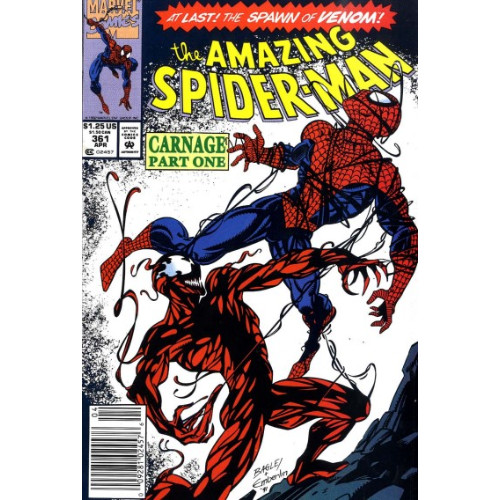
In Amazing Spider-Man #345, Eddie Brock, imprisoned after the seeming death of the alien symbiote, was freed when his "other" showed up, alive and well, bonding with the bodybuilding baddie and becoming Venom once more! In the wake of his escape, a bit of the symbiote was left behind, dripping onto Eddie’s cellmate, one Cletus Kasady.
Kasady returned in Amazing Spider-Man #359, using a mysterious red goo to yank a prison guard through the bars of his cell before escaping. The very next issue, Kasady, now resembling Venom but with a redder hue, suffocated a poor guy named "Gunny Stein" because he thought his name was stupid.
Until now, Spidey’s been unaware of Kasady…and pleasantly free from alien-adorned attackers. Yeah, he fought Venom once after Brock escaped, but the symbiote and Eddie have both been living in tranquility on a deserted island after Spidey tricked him into thinking the Web-Head was a Dead-Head. But just when you thought the reign of one parasite-wearing madman was over, Spidey learns someone’s been going on a murder spree throughout the city…somebody wearing "living skin" who swings away from scenes of…
"Carnage"
Writer: David Michelinie
Penciler: Mark Bagley
Inker: Randy Emberlin
Colorists: Bob Sharen and Renée Witterstaetter
Letterers: Joe Rosen and Rick Parker
Issues: Amazing Spider-Man #361-363
Publication Dates: April-June 1992
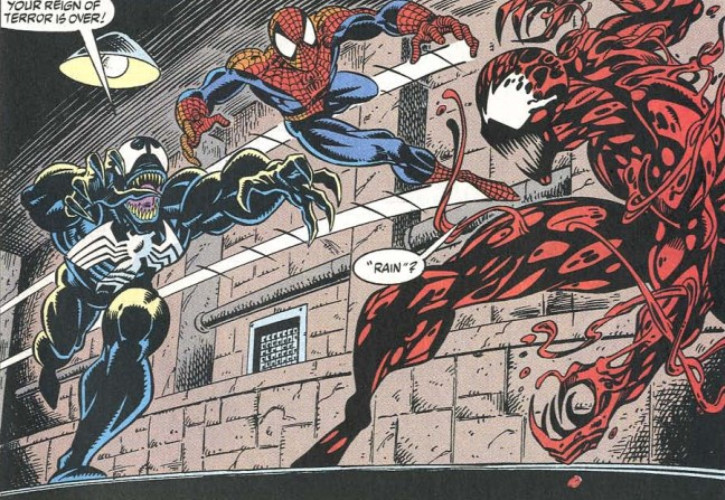
Given Venom’s popularity, it isn’t surprising another symbiote-suited supervillain soon graced the pages of Amazing Spider-Man. And given Michelinie was one-half of the creative team behind Venom's inception, it’s also not surprising he contributed to the villain’s "son." Mark Bagley, after taking a hiatus from the last few issues, gives his artistic input on Carnage’s creation, crafting a killer much more spindly and grim than the original, with red rivulets running off him like a constant stream of blood.
Visually, Carnage is quickly established as something far different and far more fearsome than his predecessor. With host Kletus Casady designed by Erik Larsen to mirror Batman’s greatest adversary, the Clown Prince of Crime hisself, it’s no surprise to see Carnage’s host sporting crazy hair, a thin frame, and toothy grin when not covered in his blood-red "other." Even before this gruesome gargoyle’s official debut, we know we’re getting a far different villain than Venom, someone a little nastier, with fewer qualms about a body count...and of whom that count consists.
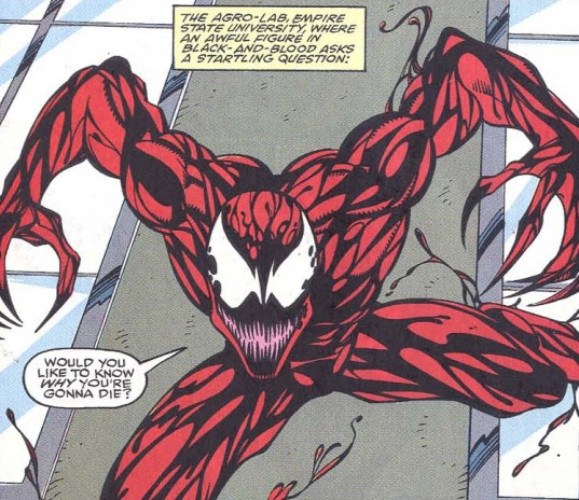
Michelinie had already woven the character into the Spider-Man mythology, and even from his few brief appearances, we’re geared towards viewing Carnage differently. Now, in this official, three-issue debut, the crazed criminal is thrust into the spotlight, and we get a full plate of just how different Carnage is from his predecessor.
Time will take both characters and hold them under that aforementioned spotlight, eventually saturating the comics medium in symbiote guest appearances, particularly when Venom begins headlining his own series. That stuff will eventually feel hollow, but before the field falls fallow, we need to examine how we got there: is Carnage just a really poor idea that’s continually used by creators? Or is there a grand concept beneath the scarlet skin that, ultimately, became stretched too thin over the years?
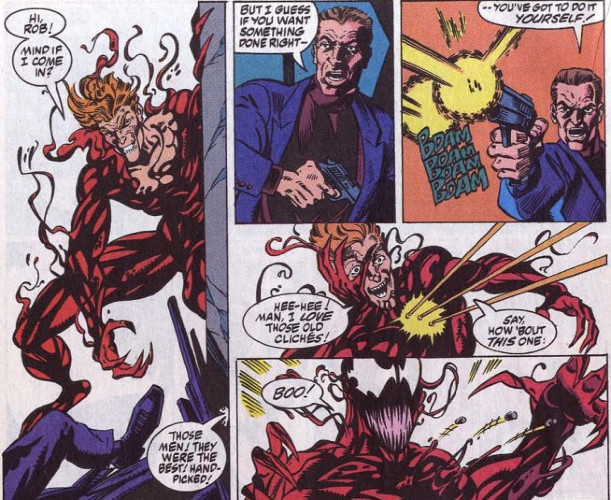
My judgement is that Carnage, as a character, has merit. By introducing Kasady earlier and teasing his appearance as Carnage, Michelinie displays that he understands where he wants to take the villain and that his intention is to create a character, not exactly the opposite of Venom, but containing contrasting qualities through which we begin viewing Venom differently. Venom, across his various appearances, has developed his own twisted sense of justice–it’s why he’ll save a crying baby in danger but continually hunts Spider-Man, believing himself an innocent individual (or, as a combination of Eddie Brock and Vemom, innocent individuals) ruined by his enemies. Venom aligns himself with the down-trodden, the woefully un-avenged. It’s this mindset which begins steering him away from outright supervillain territory and into a more morally gray designation. He’s not quite the Punisher, who’ll tear through scores of crooks that he’s already deemed doomed, but he’s also not the Green Goblin, willing to sacrifice innocents in his war on Spider-Man.
Carnage is…different.
Philosophically, Carnage aligns himself with anarchy, carving a brutal swath of destruction across New York for the sake of terror and violence. He has no point. He stands for nothing. "I’m killin’ you cause I can!" he morbidly tells one of his first victims. With Carnage, we skip past any malformed concept of "justice" and go for the jugular–why twist the truth when you can just tear it to shreds? He lacks Venom’s backstory or any proper motivation for killing Spider-Man other than the Web-Head getting in the way of his murder spree. Spidey’s an obstacle to be removed for the sake of getting rid of a potential snag rather than an enemy deserving of destruction.
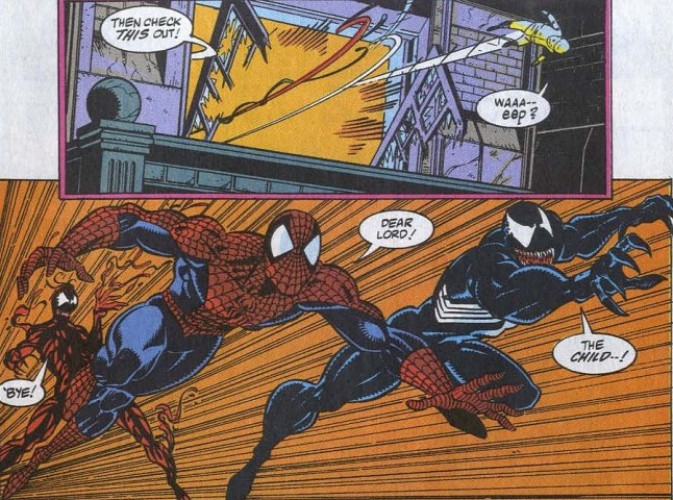
Much of that aforementioned "merit" comes from Michelinie crafting Carnage as a counterpoint to Venom. Without that thematic element peering through the pages, Carnage would feel like another goofy murderer from the 90s, all gaudy and gruesome, violent for the sake of violence. Think of the Punisher, whose lethal "war on crime" tactics grow stale after a time. Think of Youngblood, a book debuting the month after this three-part saga, created for the sole purpose of introducing big, brash, bold, and bad vigilantes, with their pouches and violence. Carnage’s shtick, at its heart, feels aimless, even if a little lazy if I want to be harsh. "Just killing to kill" lacks any substantial philosophical ties through which readers can better understand worldviews or characters. So he stabs a bunch of people because he wants to? Big flippin’ deal.
But if we see Carnage as a counter to Venom, we get somebody who now has a reason for his existence. Venom, honestly, feels more like Carnage’s arch-enemy than Spidey, at least through how they’re presented in this narrative. Going back to the Joker comparison, Carnage is the blind terrorist-esque type of criminal that kooky clown embodies–he just makes a mess. Like the Joker defies the law-and-order approach Batman wishes to bring to Gotham, haunting the Dark Knight’s evenings with more mayhem and murder, Carnage is out for blood just to force his nihilistic perspective down the throats of anyone he wants to choke on it. And though Spidey certainly hopes to end Carnage’s reign of bloodshed, it’s Venom who acts as the moral rope Carnage’s anchor of anger tugs at and threatens to snap.
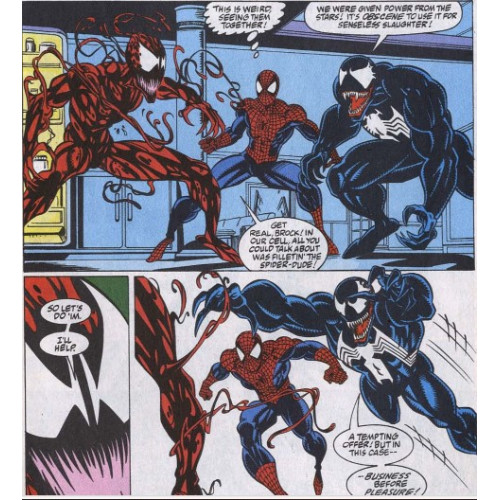
Of course, that moral rope needs to be tied to something else, and I’d argue Spidey steps in as a counter to Venom, even as they both work together to bring down Kasady. Spidey’s alliance with Venom is treated as a narrative necessity, with Carnage’s rising body count justifying why Spidey would partner with a creature who hates him as much as Venom does. It’d be easy to mull over other possibilities or question why Michelinie sees this as the only pertinent option, maybe even accuse him of writing himself into a corner just so he can bring Venom back into the series. But Michelinie executes the idea solidly–like before, the concept hinges on these previously established connections between characters. Venom is, though unknowingly at the time, responsible for Carnage’s creation, just as Spidey was obliviously responsible for the birth of Venom…and, even more indirectly, kinda responsible for Carnage himself.
We see these concepts become intertwined and affect both characters as they develop a very tenuous agreement, based on a begrudging mutual need. Spidey is wracked with his decision to form this new, though temporary partnership with Venom–can he even begin to trust a psychopathic alien enemy who’s tried murdering him on several occasions? Can he really bring Venom back to civilization? And what does he do once Carnage is stopped? Michelinie carries these tensions well through two-thirds of the narrative, not skimping on the genuine threat of Carnage while moving this subplot along. "Better the devil you know" as the saying goes, and as Spidey sides with a devil to take down a darker demon, he genuinely questions his instincts. Michelinie, similar to the last arc, has Spidey wrestle with the weight of his decision, keeping this tension from feeling surface level or flat.
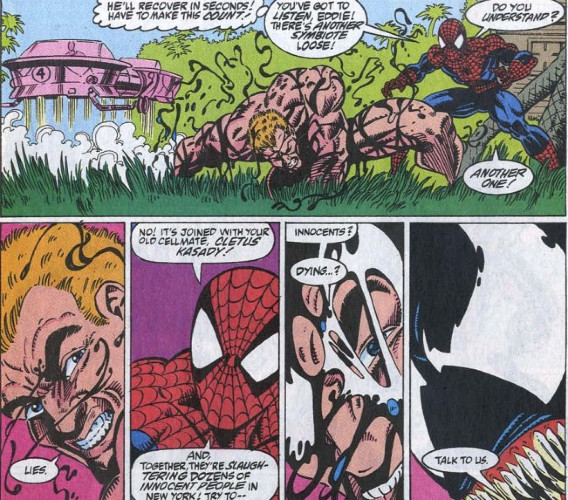
The art, though in a 2D medium, fails to appear flat itself. Mark Bagley’s redesign of Venom is somewhat surprising. This Venom is far more restrained than Larsen’s version, lacking the unhinged jaw and constant drizzle of spittle; it seems safe to say Bagley finds a healthy medium between McFarlane’s original depiction of the villain, which accentuated his bulk, and the more monstrous designs we’ve seen from Larsen and even Ron Lim. We’re not quite in that full-fledged "eat your brains!" state Venom eventually enters, meaning Bagley can create a creature that’s clearly a monster without descending into full shock horror mode.
His Kasady retains Larsen’s Joker-esque inspirations, but with Carnage, as mentioned before, Bagley is poised to create something similar yet unique from his extraterrestrial "father." Each design element–from his lithe frame, black teeth, and red coloring–feels intended to contrast Venom, despite some of their shared traits. I don't know if Bob Sharen, Renée Witterstaetter, or someone else on the creative team selected Carnage's red color scheme, but it works marvelously to counter Venom's darker tones as well as visually represent Kasady's gleeful addiction to death (or perhaps serve as a bizarre extension of his hair coloring). Bagley cleverly equips Carnage with a variety of lethal weapons, showcasing Kasady’s penchant for brutal murder rather than Venom's "beat ‘em to a pulp" mentality. These styles deliberately indicate the different perspectives between each character and Kasady’s, dare I say, joy in bonding with his alien "other." Brock and the symbiote may have joined out of a shared agenda, but Carnage…
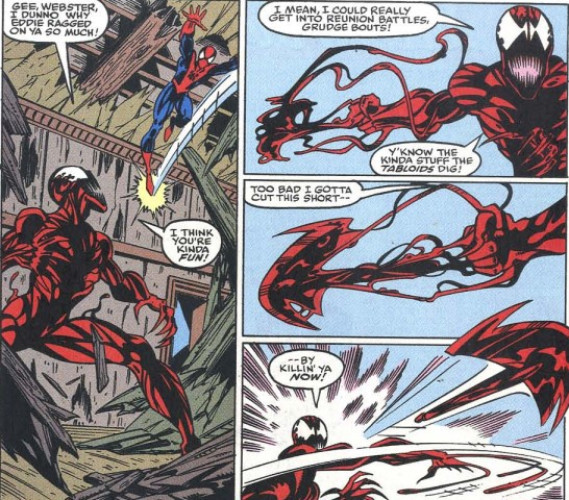
…well, I said he was different, didn’t I?
As I’ll discuss several posts from now, Carnage will eventually give way to the goofy, often goopy violent excesses of the 90s when we reach his most famous story arc, "Maximum Carnage." For now, I give Michelinie, Bagley, and Co. more credence than I may have originally when considering this narrative. You could argue Carnage was created to capitalize off the success of Venom as a character or even as a more straightforward villain so Venom could begin his journey into more morally gray territory. And I wouldn’t argue against you if you did. But you can also glimpse the creativity behind Carnage’s inception and the efforts to make him unique from his predecessor. He introduces this bizarre "generational conflict" to the Venom/Spidey dichotomy, offering a third dimension which complicates the relationship. He helps redefine who Venom is as a character, starting him off a path which will lead him away from his original villain status, transforming him into the man who will someday call himself the "lethal protector."